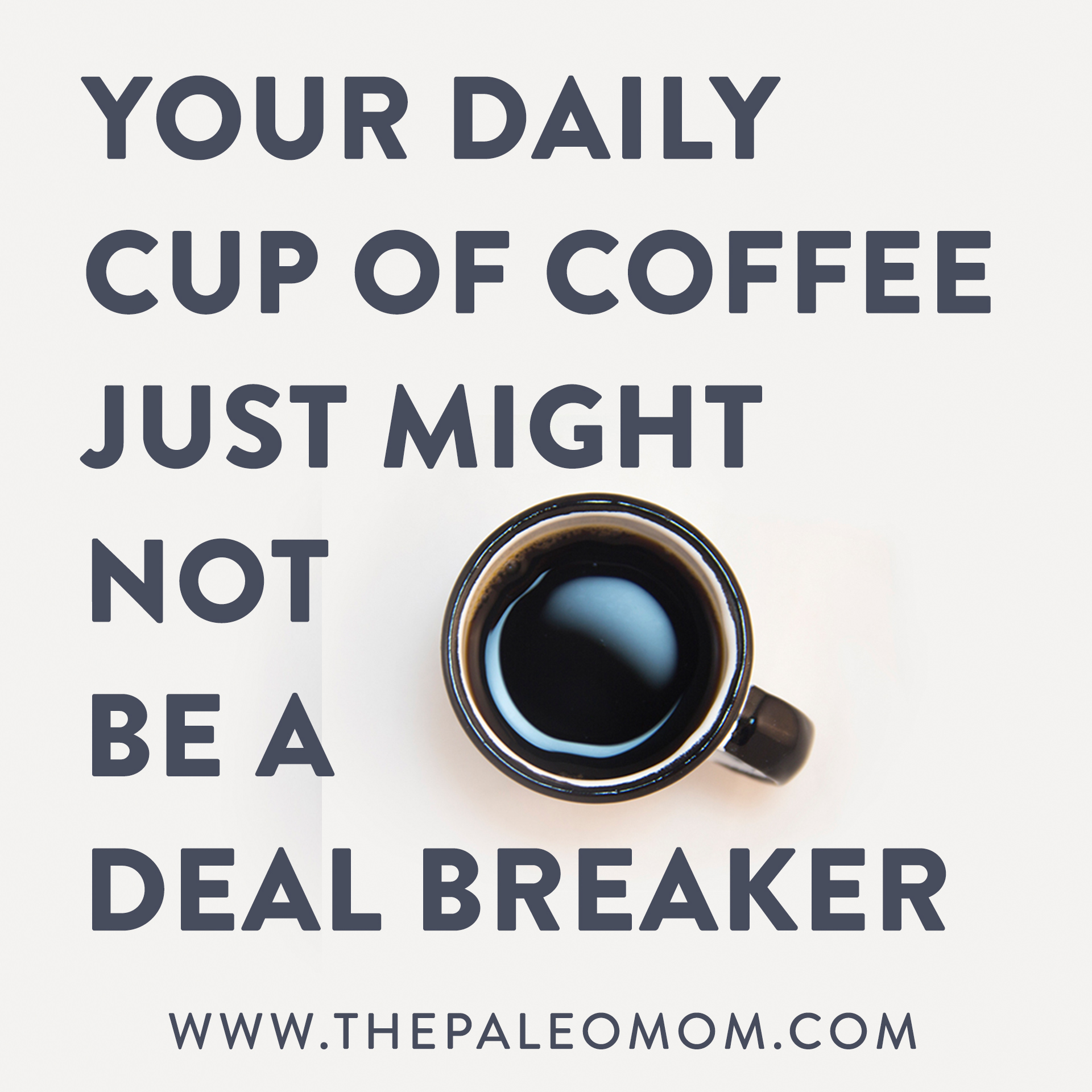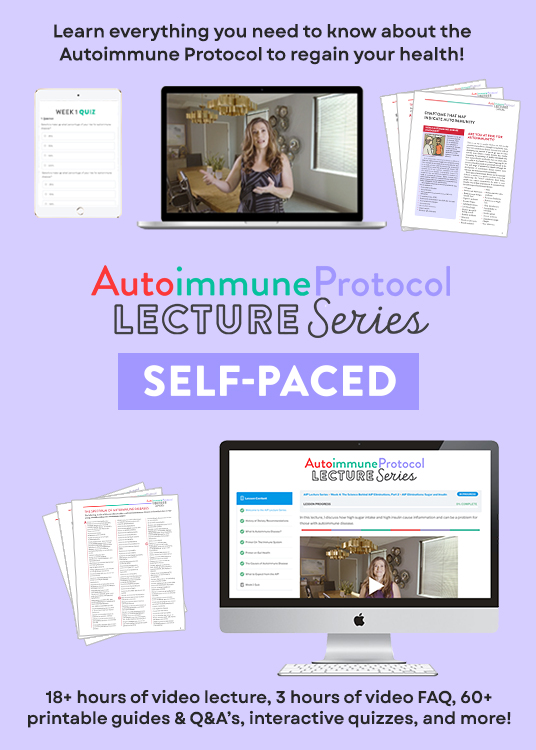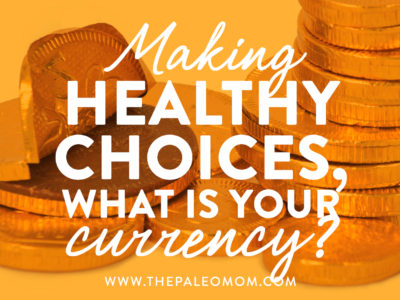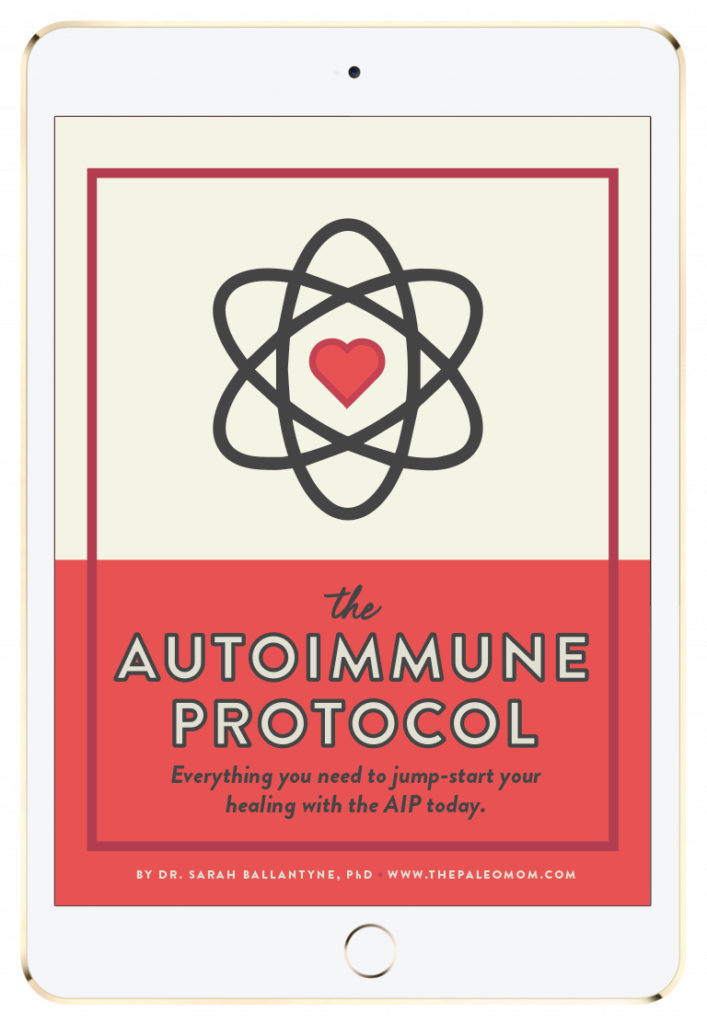The Autoimmune Protocol, or AIP, is a life-changing complementary approach to healing autoimmune disease that’s based on a somewhat radical notion: the idea that we can control our health through our food and lifestyle choices. While this idea is far from new and well-accepted for other chronic illnesses like Type 2 diabetes and cardiovascular disease, it’s one that receives little to no recognition in the context of autoimmune disease from the mainstream medical community. However, with tens of thousands of success stories and growing clinical trial evidence, there can be little doubt as to the therapeutic potential of the AIP.
Because the foundation of the dietary aspects of the AIP is consuming a diet composed predominantly of the most nutrient dense foods available to us (like organ meat, seafood, and tons of veggies)—while eliminating additional foods that can still be problematic for those with dysregulated immune systems—in the beginning it can feel strict, even compared to a standard Paleo diet. You can think of the Paleo framework as looking at what a food contains that’s beneficial for the body (nutrients) and what a food contains that might undermine our health (antinutrients, toxins, hormone dysrupters, immune dysrupters, gut irritants) and put each food on a scale. When the scale is tipped overwhelmingly to the positive (lots of nutrients, few problematic compounds), then that food is fundamentally-important food to consume; whereas when the scale is tipped overwhelmingly to the negative (few nutrients, lots of problematic compounds or high concentrations of a few problematic compounds), that’s a food that is best avoided completely. The big difference between the standard Paleo diet and the AIP is where to draw the line when it comes to the huge collection of foods that fall somewhere in between (lots of nutrients but also lots of problematic compounds). You can think of the AIP as basically a pickier version of Paleo: we only eat those foods that are clear winners. This is because those of us with autoimmune disease have immune systems that don’t regulate or function well (often in conjuction with gut dysbiosis, leaky fut, hormone dysregulation, etc.) and we are less likely to be able to tolerate a suboptimal food. So, in addition to the grains, legumes, dairy and soy eschewed by the standard Paleo diet, the AIP eliminates eggs, chocolate, coffee, nuts and seeds, nightshades and alcohol.
The AIP is an elimination diet, cutting out the foods most likely to be offenders when it comes to an overstimulated and under-regulated immune system. There is no prescribed length of time for following the elimination phase (the strict phase avoiding all of the additionally eliminated foods plus focusing on eating plenty super nutrient-dense foods to provide the immune system with the nutrient resources it needs) before reintroduction, but one month is considered a bare minimum (see Reintroducing Foods after Following the Autoimmune Protocol) and optimal is to wait until disease symptoms are completely reversed before attempting reintroductions.
But, it’s absolutely true that months of this super strict elimination diet can be very intimidating. And while, once you’ve been doing the AIP a while, it no longer seems hard nor do we typically feel deprived, getting started can be tough. There’s a learning curve, as there is to any healthy change, a time we have to get through with dedication, commitment and a seemingly constant amount of “how do I fit this into my life?!” troubleshooting. During that time, we have to relearn what foods to shop for, how to read labels, what to cook on a busy week night, what quick food to grab when we’re racing out the door, how to feed our families while avoiding tempting off-plan foods, how to balance more time in the kitchen with competing priorities like getting enough sleep, activity, and stress-reduction activities like a nature walk or meditation. There is an other side, but we have to learn how to meld our lives and priorities with the AIP to get there.
 I’ve been advocating for the AIP for those with chronic illness for about five years now, and I truly believe it’s an attainable and healing approach for everyone. But, I get that people are hesitant to pursue a strict protocol, knowing that they may, even temporarily, have to give up a favorite food. The most frequent concern I hear usually goes like this: “I would start the AIP, but I can’t give up _____.”
I’ve been advocating for the AIP for those with chronic illness for about five years now, and I truly believe it’s an attainable and healing approach for everyone. But, I get that people are hesitant to pursue a strict protocol, knowing that they may, even temporarily, have to give up a favorite food. The most frequent concern I hear usually goes like this: “I would start the AIP, but I can’t give up _____.”
Yes, it is a very common barrier to following the AIP, that one thing that someone just can’t give up. It’s usually coffee or chocolate, but sometimes it’s wine or dairy or even soda.
Here’s the thing. We think that the AIP is only worth pursuing if we complete adhere to it 100% for months on end. Certainly, doing so is definitely the most expedient way to heal, to enjoy the benefits of the AIP, and get to those life-enhancing reintroductions, but it’s not the only way to go about the AIP.
Today, I want to directly address those of you who are hesitant to start the AIP because of that one thing. And here’s the take-home message: If that one thing is keeping you from diving into the AIP, keep it in your diet and do everything else prescribed on the AIP. If this one compromise is what gets you to take that first step, to make all of the other amazing, positive, healthy choices associated with your diet and lifestyle, then that is your currency. Buy in!
The cold turkey approach to the AIP is certainly the best way to quickly see a rapid improvement in symptoms. And, by eliminating all potential triggers and adding them back in systematically  (which I detail in my book The Paleo Approach), we can very narrowly determine which foods are causing an immune response. But that approach doesn’t work for everyone, and it doesn’t need to.
(which I detail in my book The Paleo Approach), we can very narrowly determine which foods are causing an immune response. But that approach doesn’t work for everyone, and it doesn’t need to.
An AIP elimination that cuts out nightshades, eggs, dairy, grains, legumes, nuts and seeds, includes you eating 9-14 cups of vegetables a day along with a variety of organ meats yet still includes a cup of coffee every morning might still be a fantastically healing diet for you. And, if you don’t see the results you’re hoping for, you can tackle that cup of coffee in a few months.
If your lifestyle, budget or personal psychological factors make sticking with the AIP impossible, you’d be better off eliminating even a couple of the categories of potentially irritating foods than avoiding the protocol altogether.
The key with this approach is to use your own personal history as well as the severity of your disease(s) as a guide. Nightshades are a great basic starting point, as they tend to be problematic for many people. Egg whites are another food I recommend eliminating, based on anecdotal evidence.  Tomatoes have the ability to rev the immune system so alarmingly that it can take months to calm it back down again (see The WHYs Behind The Autoimmune Protocol: Nightshades). Egg White proteins can act as carrier molecules to bring proteins that activate the immune system across the lining of the gut, which is especially a problem if you are reacting to bacterial proteins from your gut microflora (see The WHYs Behind The Autoimmune Protocol: Eggs). And alcohol feed undesirable strains of bacteria in the gut while promoting a leaky gut barrier (see The WHYs behind the Autoimmune Protocol: Alcohol).
Tomatoes have the ability to rev the immune system so alarmingly that it can take months to calm it back down again (see The WHYs Behind The Autoimmune Protocol: Nightshades). Egg White proteins can act as carrier molecules to bring proteins that activate the immune system across the lining of the gut, which is especially a problem if you are reacting to bacterial proteins from your gut microflora (see The WHYs Behind The Autoimmune Protocol: Eggs). And alcohol feed undesirable strains of bacteria in the gut while promoting a leaky gut barrier (see The WHYs behind the Autoimmune Protocol: Alcohol).
Save 70% Off the AIP Lecture Series!
Learn everything you need to know about the Autoimmune Protocol to regain your health!
I am loving this AIP course and all the information I am receiving. The amount of work you have put into this is amazing and greatly, GREATLY, appreciated. Thank you so much. Taking this course gives me the knowledge I need to understand why my body is doing what it is doing and reinforces my determination to continue along this dietary path to heal it. Invaluable!
Carmen Maier

From there, you may make choices based on your personal history. If you’ve already done an elimination diet with eggs, perhaps you’ll try omitting nuts and seeds instead. If you’ve previously done a food sensitivity panel and no nuts and seeds came back positive, you may wish to keep those in your diet now and focus on kicking nightshades to the curb. And, if you’re approaching the AIP without having tried a standard Paleo diet first, you may find great relief of your symptoms with that alone!
As for our cup of coffee, glass of wine, piece of dark chocolate, handful of nuts or occasional fried egg: I want to emphasize that for those of us with autoimmune disease, enjoying these in moderation while following (most of) the AIP is a better approach for our overall health than not following it at all. Just be mindful of your improvements, and remember to periodically reassess. If you’re not where you want to be after a few months, consider eliminating the foods you were initially hesitant to cut out. If you are reacting to a food that you haven’t eliminated, that could be holding back your progress partially or completely.
Also, remember that our stress levels, how well we sleep, how active we are, and how nutrient-dense our diet is as a whole each influence how our bodies respond to an individual food. So, this might be a moving target. You may feel fine with your morning cup of joe while following the rest of the AIP normally, but when your stress levels creep up, suddenly coffee stops working for you. Being willing to reassess how things are going frequently, and not blinding ourselves to symptoms of a reaction simply because we want that particular food to be okay for our bodies is very important.
 So, where does this leave the notion of “cheating” on the AIP? Frustratingly, it really depends. Some of us are able to enjoy the occasional glass of wine or chocolate treat during the elimination phase without too much backsliding. Others will find that cheating leads to an immediate and noticeable increase in symptoms. It depends on what you cheat with, how much you eat, how often you cheat, and on your specific health conditions and food sensitivities. In general, I recommend sticking to at least a basic Paleo diet if you’re planning to cheat while on the AIP. This would mean avoiding grains (especially gluten containing grains), legumes (especially soy and peanuts), and I urge strong caution with dairy (especially pasteurized conventional dairy). Grassfed butter and ghee might be exceptions that don’t cause any noticeable effects.
So, where does this leave the notion of “cheating” on the AIP? Frustratingly, it really depends. Some of us are able to enjoy the occasional glass of wine or chocolate treat during the elimination phase without too much backsliding. Others will find that cheating leads to an immediate and noticeable increase in symptoms. It depends on what you cheat with, how much you eat, how often you cheat, and on your specific health conditions and food sensitivities. In general, I recommend sticking to at least a basic Paleo diet if you’re planning to cheat while on the AIP. This would mean avoiding grains (especially gluten containing grains), legumes (especially soy and peanuts), and I urge strong caution with dairy (especially pasteurized conventional dairy). Grassfed butter and ghee might be exceptions that don’t cause any noticeable effects.
It is always easier to cheat successfully after following the AIP for long enough to see improvements and after attempting a variety of reintroductions. I started following the AIP over five years ago. After 10 months, I was able to reintroduce some foods (nuts, seeds, coffee, chocolate, and the occasional glass of wine) but not others (nightshades, eggs, dairy) and found that some non-Paleo foods seems okay once in a while (corn and rice), so now, when I do have a food that is off-plan, I stick within my own boundaries: I know that eating a tomato will cause symptoms that will last weeks to months, so I never eat a tomato. But, I know that enjoying popcorn at the movies, will be okay, so that’s an indulgence I feel comfortable with.
And what if cheating (or reintroducing a food that doesn’t work for us) causes a reaction? Well, yes, set-backs are frustrating. But, the key here is that the AIP provides us with a powerful tool that we can always come back to to expedite healing and recovery. We all fall down, once in a while, and all we can do is pick ourselves back up, dust ourselves off, reevaluate and move forward. And, falling off the wagon, even for a few days, won’t necessarily set you back to square one. As always, the affects of a particular food will be determined by your own history and by other factors, like how well-rested you are, your stress and activity level and more. The trick is to find a balance between what your body will tolerate and what it needs to heal. It’s all about finding a sustainable approach with which you can live and thrive!
So, if giving up that one thing is a non-starter for you, instead of thinking of it as a barrier to making healthy changes, think of it as your currency. If trading keeping that one thing in your life allows you to finally take steps towards regaining your health, that’s a deal worth taking!










